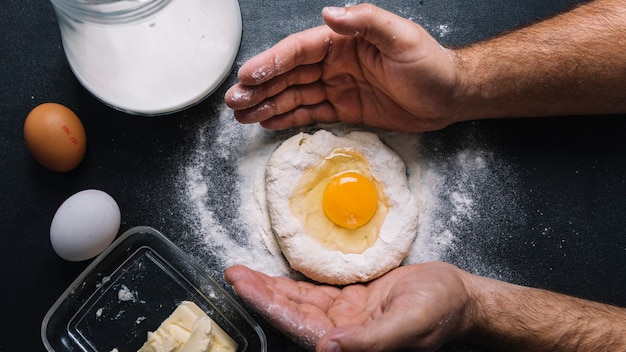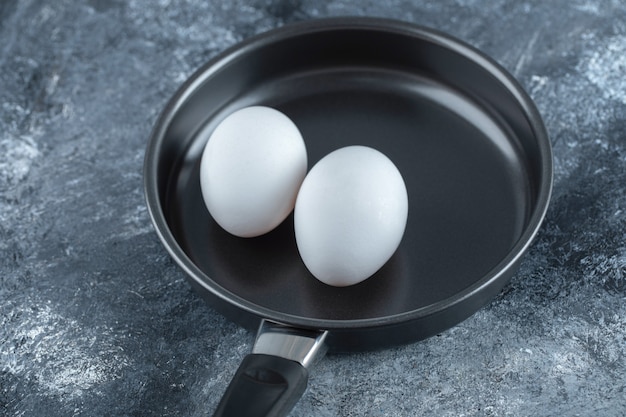We’ve all been there: craving a boiled egg but lacking the time for a traditional stovetop boil. You might think, "Can't I just zap it in the microwave?" I'm here to tell you, it's not as straightforward as it seems. Microwaving a boiled egg isn't like nuking a cup of soup. It's a delicate operation that requires understanding the science behind it and mastering a few key techniques. If you're not careful, you could be dealing with a messy, explosive situation.
Don't worry, though! I'm here to guide you through the world of microwaving boiled eggs. From the biggest no-nos to the safest methods and beyond, I'll share everything I've learned. By the end, you'll be a microwave egg master, confidently heating up your breakfast with a smile.
Part 1: The Big No-No’s

Before we dive into the dos and don'ts, let's start by addressing the elephant in the room: microwaving hard-boiled and raw eggs is a big, fat no. Trust me, I’ve learned this lesson the hard way.
Don't Microwave hard-boiled eggs!
Let’s be clear: microwaving hard-boiled eggs is a recipe for disaster. They're already encased in a sturdy shell, and the heat from the microwave will create an internal pressure buildup that’s like a volcano waiting to erupt. And erupt it will, leaving a gooey mess all over your microwave.
I remember back in my university days, trying to make a quick breakfast. I thought, "Why bother with boiling water when I can just microwave this hard-boiled egg?" Big mistake. The egg exploded, splattering my microwave with hot egg yolk. It took me a good hour to clean it up, and it was a messy, smelly lesson I’ll never forget.
Don't Microwave Raw Eggs
Now, you might be thinking, "Well, if I can’t microwave hard-boiled eggs, what about raw ones?" The answer is still a big no.
Raw eggs are full of moisture, and when you microwave them, that moisture turns into steam. This steam builds up pressure inside the egg, creating a potential explosion. The mess is even worse than with hard-boiled eggs because raw egg is sticky and harder to clean.
I've never actually microwaved a raw egg, but I've seen the horrors online. Trust me, it's not something you want to experience.
Part 2: The Safe Way to microwave eggs

So, we've established that hard-boiled and raw eggs are off-limits for the microwave. But what about soft-boiled eggs? Believe it or not, you can actually microwave them safely, but only if you follow a few key rules.
Microwaving Soft-Boiled Eggs: The Shell is Key
The secret to microwaving soft-boiled eggs safely is all about the shell. You need to crack it, but not completely break it. The crack needs to be big enough to allow the steam to escape, preventing pressure buildup and an egg-splosion.
To crack the shell, gently tap the egg on the countertop, just enough to create a small fissure.
The Best Method: A Step-by-Step Guide
Here’s my tried-and-true method for microwaving soft-boiled eggs:
1. Choose your egg: Start with a soft-boiled egg that’s been cooked for about 4-5 minutes. This ensures the yolk is runny but the white is set.
2. Crack the shell: Give the egg a gentle tap on the countertop to create a small crack.
3. Find a safe spot: Place the egg in a microwave-safe bowl or mug.
4. Add a little water: Add a tablespoon or two of water to the bowl or mug. This will help create steam and prevent the egg from drying out.
5. Microwave in bursts: Microwave on high for 10-15 seconds at a time.
6. Check and repeat: After each interval, check the egg for doneness. Continue microwaving in 10-second bursts until the egg is heated through to your liking.
This method allows you to heat the egg gently and safely, ensuring it stays intact.
Important Tips to Remember
Here’s a recap of the key points for microwaving soft-boiled eggs:
1. Crack the shell, but not too much.
2. Add a small amount of water to create steam.
3. Microwave in short bursts.
4. Check the egg frequently.
Part 3: Microwave Egg-cellent Recipes

Now that you’ve mastered the art of microwaving soft-boiled eggs, let’s explore some other delicious egg-based dishes you can prepare in your microwave.
scrambled eggs in the Microwave: A Quick and Easy Breakfast
You might be surprised to learn that you can make a fantastic scrambled egg in your microwave. It’s quick, easy, and perfect for a busy morning.
Here's what you'll need:
1. 2 eggs
2. 1 tablespoon milk
3. Pinch of salt
4. Pinch of pepper
Here's how to do it:
1. Crack the eggs: Crack the eggs into a microwave-safe bowl.
2. Mix it up: Add the milk, salt, and pepper, and whisk until well combined.
3. Microwave: Microwave on high for 30-45 seconds, or until the eggs are just set. Stir halfway through to ensure even cooking.
Serve with toast, or add chopped vegetables like spinach or bell peppers for a more substantial meal.
Omelet in the Microwave: A Surprisingly Delicious Treat
Yes, you read that right - omelets in the microwave! It might sound a bit odd, but it actually works. It’s a quick and easy way to enjoy a tasty omelet without the hassle of a pan.
You'll need:
1. 2 eggs
2. 1 tablespoon milk
3. Pinch of salt
4. Pinch of pepper
5. Your favorite fillings (cheese, ham, vegetables)
Here's how to make it:
1. Crack the eggs: Crack the eggs into a microwave-safe bowl.
2. Mix it up: Add the milk, salt, and pepper, and whisk until well combined.
3. Add your fillings: Add your desired fillings to the egg mixture.
4. Microwave: Microwave on high for 30-45 seconds, or until the eggs are just set.
5. Fold it up: Carefully fold the omelet in half.
Voila! You have a delicious, perfectly-cooked microwave omelet.
Part 4: Egg-ceptional Tips and Tricks
Let's talk about some helpful tips and tricks to ensure your microwave egg experience is as smooth and enjoyable as possible.
Egg-splosion Prevention: Avoid Disaster
Remember, the key to successful microwaving eggs is preventing an egg-splosion. Here are a few tips to avoid this:
1. Crack the shell: Always crack the shell of soft-boiled eggs before microwaving.
2. Use the right container: Always use a microwave-safe bowl or mug.
3. Add water: Add a small amount of water to the bowl or mug to create steam.
4. Microwave in bursts: Microwave in short bursts of 10-15 seconds to allow the egg to cook evenly.
5. Check it out: Check the egg frequently to ensure it's not overcooked.
Cleaning Up After an Egg-splosion: A Guide to Recovery
Let’s face it, sometimes, even with the best intentions, an egg-splosion can happen. If that happens, don’t panic! Here’s how to handle the mess:
1. Let it cool: Let the microwave cool completely before attempting to clean it.
2. Remove the big stuff: Remove any large pieces of egg with a paper towel.
3. Wipe it down: Wipe the inside of the microwave with a damp cloth.
4. Tackle tough stains: For stubborn stains, use a mixture of baking soda and water.
5. Let it dry: Let the microwave air dry completely.
Egg-tra Safety: Keep It Safe
Microwaving eggs is a risky business, so it’s essential to prioritize safety. Here are a few extra tips:
1. Never leave it unattended: Never leave a microwaved egg unattended.
2. Use caution: Always use oven mitts or a potholder when handling a hot microwaved egg.
3. Keep it safe: Keep children and pets away from the microwave when it’s in use.
Part 5: Egg-cellent FAQs
Here are some frequently asked questions about microwaving eggs:
Can you microwave an egg in its shell?
No, absolutely not! Microwaving an egg in its shell is a guaranteed way to create an egg-splosion. The pressure buildup will cause the egg to burst, making a mess of your microwave.
Can you microwave a deviled egg?
Nope, not recommended. deviled eggs are already hard-boiled, and microwaving them will cause the same pressure buildup issues as a whole hard-boiled egg.
Can you microwave eggs with the yolk intact?
Yes, you can microwave eggs with the yolk intact, but only if you crack the shell to allow steam to escape. This prevents pressure buildup and explosion.
Can you microwave a cracked egg?
Yes, you can microwave a cracked egg, and it’s actually recommended to crack the shell of a soft-boiled egg before microwaving it. This allows steam to escape, preventing an egg-splosion.
What happens if you microwave an egg too long?
If you microwave an egg too long, it can become rubbery and overcooked. The yolk will become hard and dry, and the white will be tough and chewy.
Part 6: The Egg-ceptional Conclusion
And there you have it, folks! The ultimate guide to microwaving boiled eggs.
We’ve learned that microwaving hard-boiled or raw eggs is a definite no-no. But with the right technique, you can safely and successfully microwave soft-boiled eggs. Remember to crack the shell, add a little water, and microwave in short bursts, checking the egg frequently.
We’ve also explored some delicious microwave egg recipes, from scrambled eggs to omelets. And we’ve covered essential tips and tricks for preventing egg-splosions and cleaning up any messes.
So go forth, my egg-cellent friends, and confidently microwave your boiled eggs like a pro. Just remember to be careful, and always err on the side of caution. And most importantly, have fun with it!
Everyone is watching

How to Cook Frozen Lobster Tails Perfectly: A Step-by-Step Guide
RecipesLobster. Just the word conjures up images of lavish meals, special occasions, and a taste of luxury. But let's...

Pigs in a Blanket Cooking Time: How Long to Bake for Perfect Results
RecipesAh, pigs in a blanket. Just the name conjures up images of those delightful little parcels of crispy pastry en...

Pork Fillet Cooking Time: How Long to Cook It Perfectly
RecipesPork fillet, or tenderloin as it's sometimes called, is a real favourite in our house. It's so versatile, and...

The Ultimate Guide to Tender, Juicy Pulled Pork
RecipesRight, let's talk pulled pork. It's one of those dishes that just screams "comfort food," doesn't it? I mean...

The Ultimate Guide to Cooking Sweet Potatoes: From Roasting to Mashing
RecipesSweet potatoes. Just the name conjures up images of warm, comforting dishes, bursts of vibrant color, and a to...
